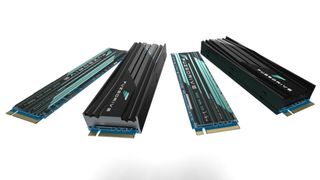The Frankenstein of SSDs is now shipping - but is it too little, too late?
Former AMD storage partner unleashes FuzeDrive SSD via Indiegogo

Back in January, storage company Enmotus - which once partnered with AMD - announced it would launch an SSD that combined SLC and QLC NAND chips: the MiDrive.
Fast forward to November 2020 and, after a successful Indiegogo campaign that saw more than 600 backers invest almost $200,000, the product is being shipped - albeit under a different moniker.
The FuzeDrive SSD, as it is now known, is presented as the first AI-powered NVMe SSD - one that combines SLC and QLC on a single board to maximize performance, endurance and capacity. The SLC, in this context, is used as a permanent primary storage rather than just as cache.
- Check out our list of the best portable SSDs available
- Here's our list of the best cloud storage services right now
- We've built a list of the best cloud backup services on the market
According to the firm, the secret sauce is the AI layer that gels everything together. “The application of AI to actively manage SSD flash in gaming environments provides an entirely new approach to achieving smooth, consistent and long-lasting performance without sacrificing capacity”, said Andy Mills, Enmotus CEO.
As for the price, the 1.6TB version (1.5TB QLC, 128GB SLC) has an SRP of $349 and includes a data migration and capacity expansion software bundle, plus a five year warranty.
It boasts a claimed read/write performance of 3.47GBps/3GBps respectively and a whopping 3,600TBW. That’s exactly the same as the Sabrent Rocket NVMe 4.0 2TB SSD, which is faster and cheaper without having to resort to software tricks.
That said, the FuzeDrive was deemed good enough to receive the best of show award for the most innovative Flash Memory Consumer Application at the Flash Memory Summit 2020.
Are you a pro? Subscribe to our newsletter
Sign up to the TechRadar Pro newsletter to get all the top news, opinion, features and guidance your business needs to succeed!
According to the company's website, the drive will soon be available via major retailers, including Amazon.
- Here's our list of the best external hard drives right now

Désiré has been musing and writing about technology during a career spanning four decades. He dabbled in website builders and web hosting when DHTML and frames were in vogue and started narrating about the impact of technology on society just before the start of the Y2K hysteria at the turn of the last millennium.
